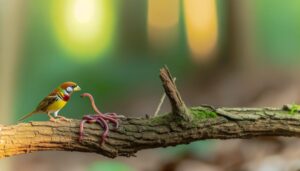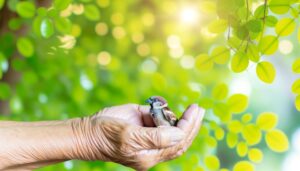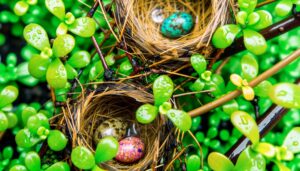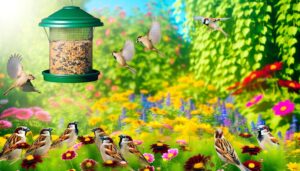7 Simple Steps to Make a Sparrow Bird Feeder
Constructing a sparrow bird feeder requires untreated wood, nails, a hammer, saw, sandpaper, and measuring tape. Begin by cutting weather-resistant cedar or pine into specified dimensions, sanding the edges, and drilling drainage holes.
Assemble a sturdy frame using strong joints and galvanized screws, ensuring stability. Install level perches using dowel rods, and affix a roof with an overhang.
Fill the feeder with a birdseed blend optimized for sparrows, containing millet, sunflower hearts, and canary seed. Hang the feeder in a suitable location, periodically inspecting and cleaning it.
For detailed step-by-step instructions, further exploration of this guide is recommended.
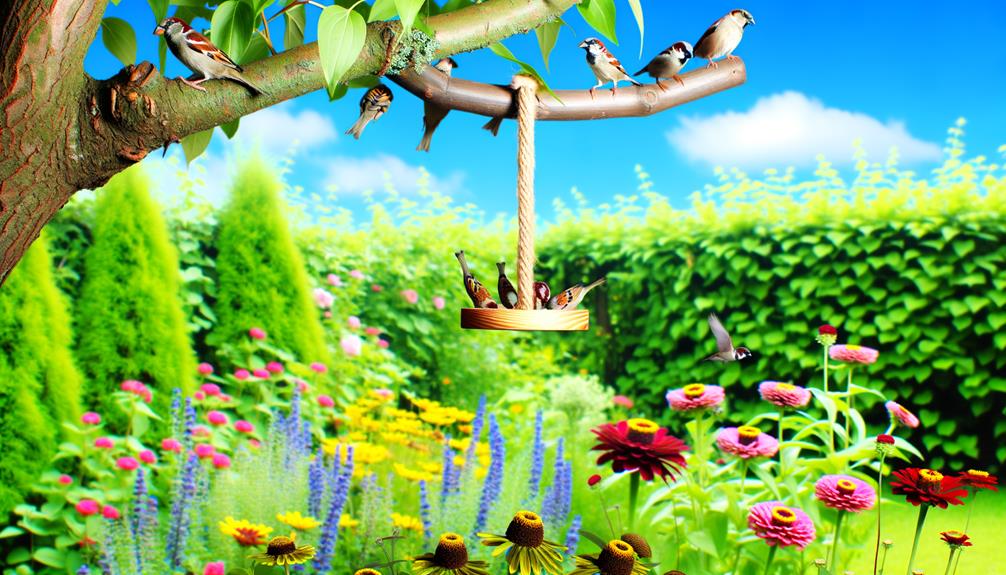
Key Takeaways
- Use untreated, weather-resistant wood like cedar or pine for durability and safety.
- Cut wood to specified dimensions and sand edges for a smooth finish.
- Assemble a sturdy frame with drainage holes using galvanized screws and nails.
- Install dowel rod perches securely to provide stable and level resting spots.
- Fill the feeder with a blend of millet, sunflower hearts, and canary seed for sparrows.
Gather Your Materials
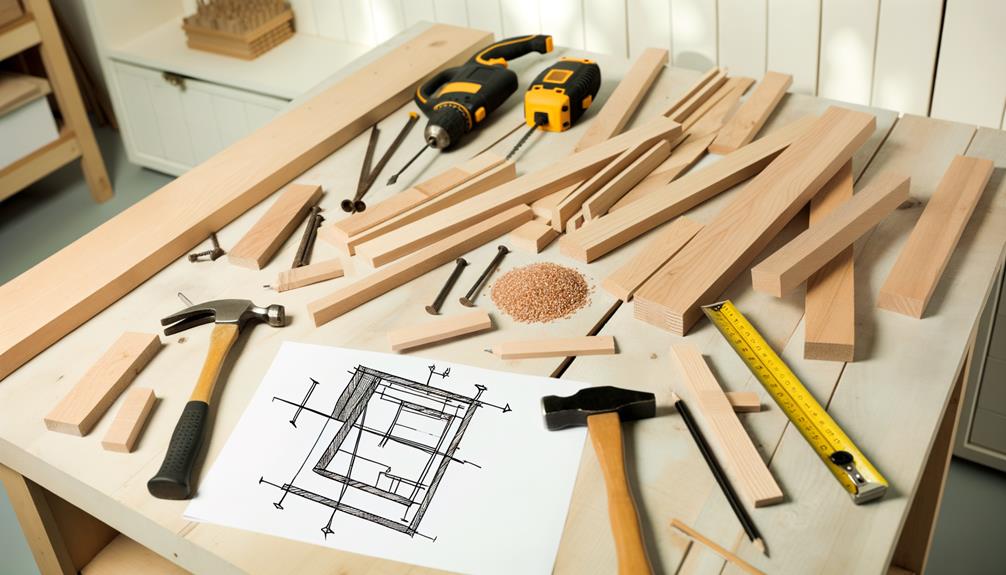
To begin constructing a sparrow bird feeder, it is important to first assemble a thorough list of materials. This includes untreated wood, nails, a hammer, a saw, sandpaper, a measuring tape, and birdseed.
Untreated wood is vital as it avoids harmful chemicals that could jeopardize avian health. Nails and a hammer will secure structural integrity, while a saw is necessary for precision cuts. Sandpaper guarantees smooth edges, preventing injury to birds. A measuring tape is essential for accurate dimensions, guaranteeing the feeder is appropriately sized for sparrows. Birdseed is the final component, providing the sustenance that attracts sparrows.
Properly gathering these materials guarantees the foundational steps are meticulously executed, setting the stage for a successful build.
Choose the Feeder Design
Selecting the right feeder design is essential for best sparrow attraction and feeding efficiency.
Two primary categories to ponder are simple DIY options, which allow for customization and material selection, and ready-made choices, which offer convenience and proven functionality.
Each design type presents unique benefits and potential drawbacks that must be evaluated based on your specific requirements and environmental conditions.
Simple DIY Options
When selecting a feeder design for sparrows, take into account the specific feeding habits and dietary preferences of these small, seed-eating birds. Sparrows are ground foragers, preferring platforms or tray feeders that offer ample space for perching and feeding. Choose a straightforward DIY platform feeder made from durable materials like wood or metal. Make sure the feeder has drainage holes to prevent seed spoilage and is raised to deter predators.
Another efficient design is a tube feeder with multiple feeding ports, accommodating their social feeding behavior. Integrate perches near the ports to facilitate access. Furthermore, hanging mesh feeders can be appropriate for providing seeds while reducing waste. Each design should prioritize ease of cleaning to maintain hygiene and bird health.
Ready-Made Choices
For those who prefer not to construct their own feeders, commercially available options offer a variety of designs specifically engineered to accommodate the feeding behaviors and dietary needs of sparrows.
Hopper feeders, for instance, provide a continuous feed supply and are designed to minimize spillage, which is ideal for sparrows' ground-feeding tendencies.
Tube feeders with multiple perches allow several sparrows to feed simultaneously, promoting social feeding behaviors.
Mesh feeders offer a versatile option for holding various seed types, accommodating sparrows' diverse diet.
Additionally, platform feeders, often equipped with drainage systems to prevent water accumulation, guarantee seeds remain dry and palatable.
Each design considers sparrows' size, feeding habits, and dietary preferences, making them effective and convenient solutions for bird enthusiasts.
Prepare the Base
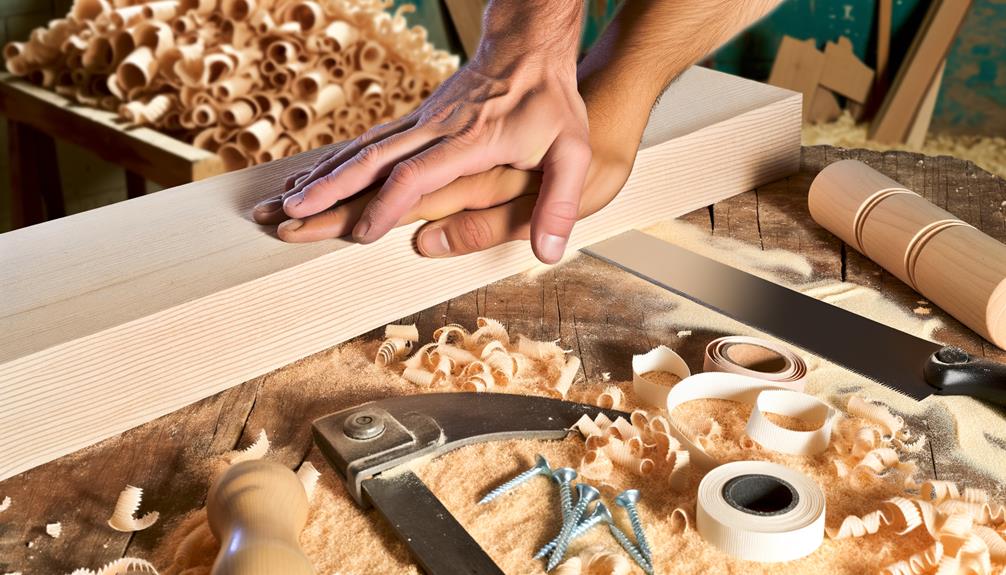
To prepare the base of your sparrow bird feeder, start by selecting a sturdy, weather-resistant material such as cedar, pine, or recycled plastic. These materials provide the necessary durability to withstand outdoor conditions.
Cut the chosen material into a rectangular shape, guaranteeing dimensions of approximately 12 inches by 8 inches to provide adequate space for feeding. Sand the edges to remove any splinters, creating a smooth surface that minimizes harm to the birds.
Drill several small drainage holes, roughly 1/8 inch in diameter, evenly spaced across the base to prevent water accumulation, which can lead to mold growth. A thorough preparation of the base secures structural integrity and enhances the longevity of your sparrow bird feeder.
Construct the Frame
Constructing the frame demands precise measurements and the use of high-quality, weather-resistant materials to guarantee the stability and durability of the sparrow bird feeder.
Begin by selecting rot-resistant wood species such as cedar or redwood. Cut four identical lengths for the vertical supports and four equal lengths for the horizontal beams using a mitre saw for accuracy. Confirm the dimensions are consistent with the base size previously prepared.
Assemble the frame by joining the vertical and horizontal components with galvanized screws and wood glue, which provide robust, long-lasting joints. Utilize a carpenter's square to maintain right angles during assembly.
This structural framework serves as the primary support, ensuring the feeder withstands environmental stressors such as wind and precipitation.
Add Perches
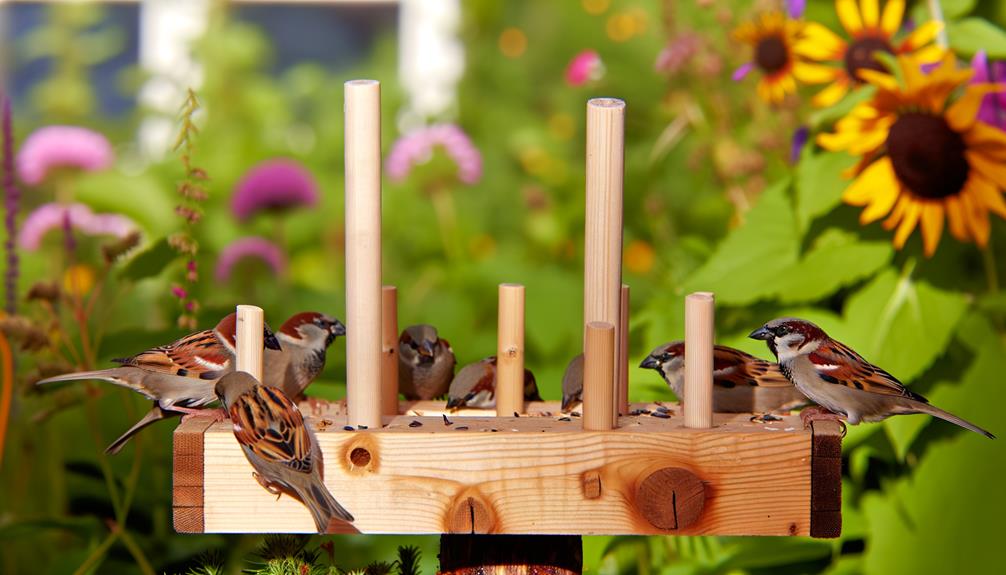
With the frame securely assembled, the next step involves installing perches to facilitate comfortable feeding spots for sparrows. Perches should be strategically positioned near the feeding ports to guarantee easy access.
Utilize dowel rods, approximately 0.5 inches in diameter, which provide adequate grip for sparrows' feet. Cut the rods into 3 to 4-inch sections. Drill corresponding holes into the frame, making sure they are horizontally aligned and evenly spaced.
Insert the dowel rods securely into these holes, using wood glue for additional stability if necessary. Making sure the perches are level and stable is vital for preventing tipping and ensuring the sparrows' safety.
Properly installed perches will enhance the feeder's functionality and encourage frequent visits from sparrows.
Attach Feeding Ports
To guarantee peak functionality and durability of the feeder, it is essential to select materials that are resistant to weather and wear for the feeding ports.
Precise measurement and marking of port locations will facilitate even distribution of feed and minimize spillage.
Selecting Appropriate Materials
Selecting the suitable materials for attaching feeding ports is essential to secure both the durability and functionality of a sparrow bird feeder.
High-density polyethylene (HDPE) is recommended due to its robust resistance to environmental stressors such as UV radiation and moisture.
Stainless steel screws or rivets should be employed to secure a firm attachment, mitigating the risk of corrosion over time.
Additionally, silicone-based sealants can be utilized to waterproof the edges, preventing seed spoilage and maintaining hygiene.
It is advisable to avoid materials like untreated wood, which may degrade rapidly when exposed to the elements.
Measuring and Marking Locations
Accurate measurement and precise marking of feeding port locations are crucial for the efficient distribution of seeds and top access for sparrows. Begin by using a ruler or measuring tape to establish equidistant points around the feeder's circumference. This guarantees consistency in seed distribution. Mark these locations with a pencil, making sure they align both horizontally and vertically. Proper spacing prevents overcrowding and facilitates smooth seed flow.
| Measurement Tool | Purpose |
|---|---|
| Ruler | Measure distances |
| Measuring Tape | Check circumference |
| Pencil | Mark port locations |
| Spirit Level | Ensure horizontal alignment |
Attention to these details guarantees prime sparrow feeding conditions, promoting their health and well-being.
Securing Feeding Ports Properly
Securing the feeding ports involves using appropriate fasteners to ensure they remain stable and functional under varying environmental conditions. Begin by selecting stainless steel screws or weather-resistant bolts, which offer peak durability.
Pre-drill holes in the designated locations to prevent wood splitting and facilitate precise alignment. Utilize washers to distribute the load evenly, reducing stress on the material.
Apply a waterproof sealant around the edges of the ports to prevent moisture ingress, which could compromise structural integrity. Regularly inspect the fasteners for signs of corrosion or loosening, and tighten them as needed.
Assemble the Feeder
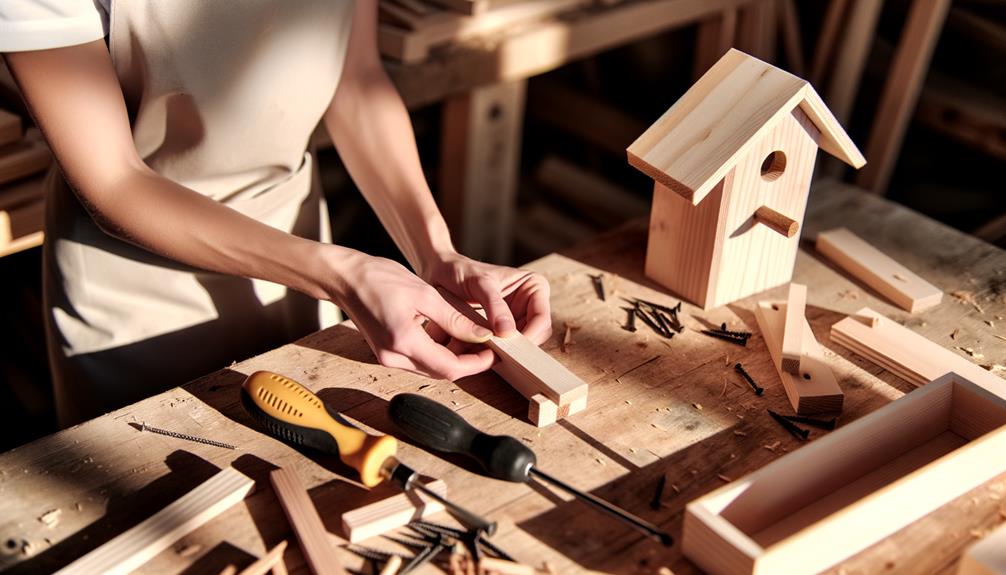
Begin by aligning the pre-cut wooden panels on a flat surface, confirming that each piece corresponds correctly according to the blueprint specifications. Use a carpenters' square to verify right angles and secure precise alignment.
Proceed by applying wood glue to the edges where panels will join, promoting structural integrity. Affix the panels together using galvanized screws, which resist rust and guarantee long-lasting durability. Employ a power drill with a countersink bit to prevent wood splitting and achieve a flush finish.
For the roof assembly, maintain a slight overhang to shield the interior from precipitation. Finally, verify all joints for stability and uniformity. Allow the glue to cure for 24 hours before proceeding to any further steps in the construction process.
Fill With Birdseed
After ensuring the structural integrity of the assembled feeder, proceed to fill the interior compartment with a high-quality birdseed blend optimized for sparrows. This blend should contain a variety of seeds that cater specifically to the dietary preferences of sparrows, ensuring their nutritional needs are met.
- Millet: A staple for sparrows due to its small size and high carbohydrate content, promoting energy.
- Sunflower Hearts: Offering essential fats and proteins, sunflower hearts are easily accessible and digestible.
- Canary Seed: Known for its high protein content, it supports muscle development and overall health.
Carefully pour the birdseed blend into the feeder, ensuring even distribution to prevent clogging and facilitate continuous access.
This meticulous selection process will attract sparrows and support their well-being effectively.
Hang Your Feeder
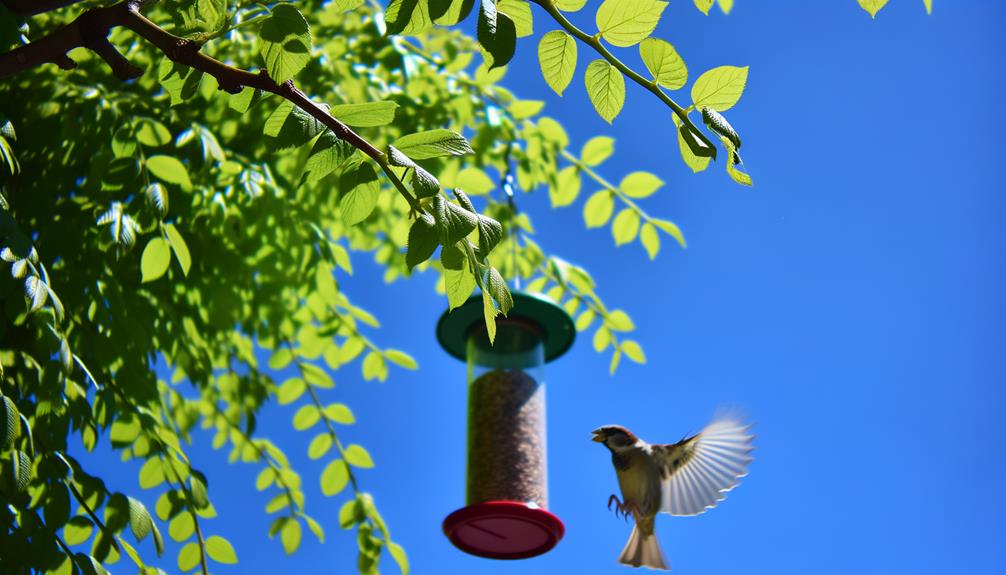
Choosing a suitable location to hang your feeder is crucial for maximizing sparrow visitation and promoting their safety. Ideally, position the feeder at a height of 5-7 feet to deter ground predators. Select a spot with nearby shrubbery or trees to provide perching and shelter options for sparrows, enhancing their sense of security.
Ensure the feeder is visible but not exposed to harsh weather conditions, such as strong winds or direct sunlight, which can degrade seed quality. Utilize a sturdy mounting mechanism, like a metal hook or nylon cord, to avoid feeder dislodgment.
Regularly inspect the feeder's condition and surrounding area for potential hazards, such as sharp objects or excessive debris, to maintain an ideal feeding environment for sparrows.
Conclusion
To sum up, the construction of a sparrow bird feeder, via methodical assembly and precision, encapsulates the intricate dance between human ingenuity and nature's simplicity.
By carefully selecting materials, designing a functional frame, and incorporating perches and feeding ports, the feeder becomes a conduit for avian sustenance.
This endeavor not only fosters an enriching habitat for sparrows but also exemplifies the delicate interplay of craftsmanship and ecological harmony, thereby contributing to the broader tapestry of environmental stewardship.


